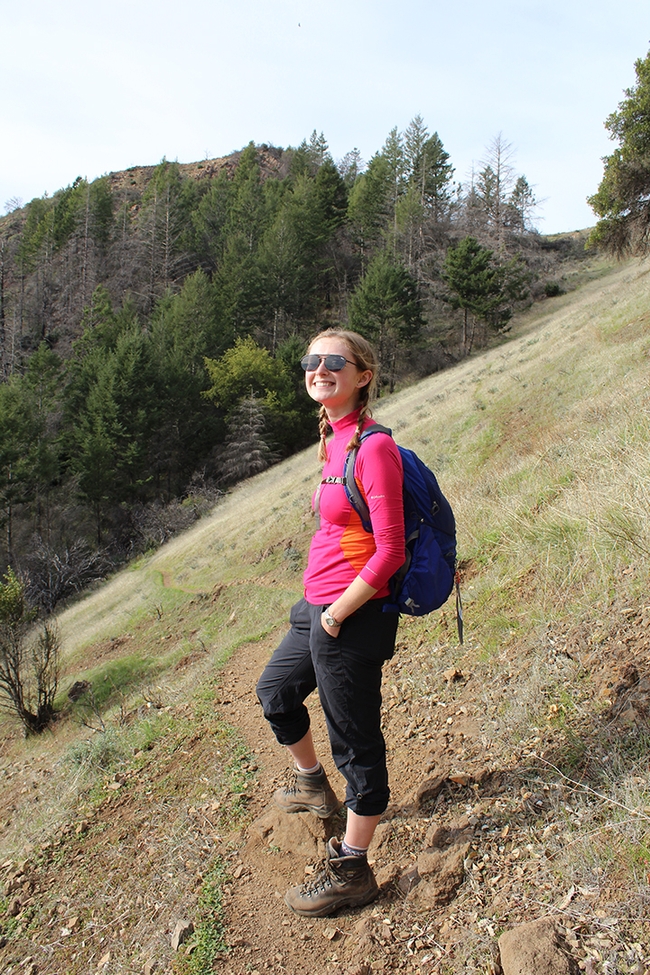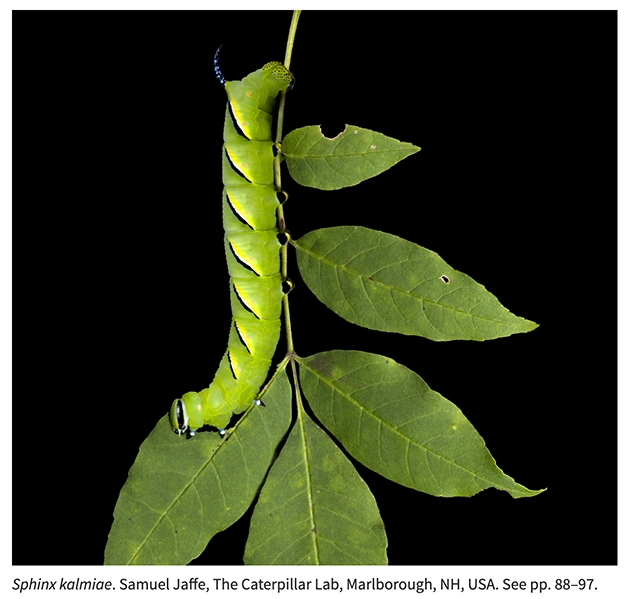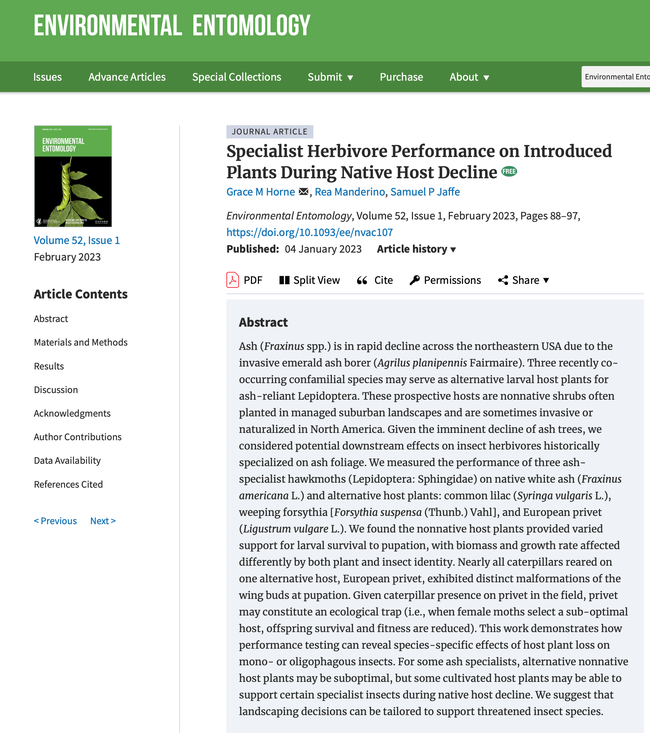
But that's the case with UC Davis doctoral student Grace Horne. Her undergraduate thesis about the effects of the decline of ash trees on native caterpillars, scored the cover of the February edition of the journal Environmental Entomology. Or, should we say, it "graced" the cover.
The paper, “Specialist Herbivore Performance on Introduced Plants During Native Host Decline,” is co-authored by Ria Manderino of the Oak Spring Garden Foundation, Upperville, VA and Samuel Jaffe of The Caterpillar Lab, Marlborough, N.H.
“Our publication highlights the importance of multispecies assessments of host plant acceptance,” said Horne, who studies plant-insect interactions, urban ecology, global change biology, natural history and community science in the laboratory of urban landscape entomologist Emily Meineke, assistant professor, UC Davis Department of Entomology and Nematology.
“We tested three related species, two of them congeners, on their ability to accept alternative host plants in the face of the loss of their primary host," Horne said. "We found a diversity of responses even among these three species. Further downstream, landscape managers may be able to use our results to make decisions about which plantings will help support native herbivores.”
Jaffe provided the cover image of a Sphinx kalmiae, commonly known as "laurel sphinx."
The abstract:
Ash (Fraxinus spp.) is in rapid decline across the northeastern USA due to the invasive emerald ash borer (Agrilus planipennis Fairmaire). Three recently co-occurring confamilial species may serve as alternative larval host plants for ash-reliant Lepidoptera. These prospective hosts are nonnative shrubs often planted in managed suburban landscapes and are sometimes invasive or naturalized in North America. Given the imminent decline of ash trees, we considered potential downstream effects on insect herbivores historically specialized on ash foliage. We measured the performance of three ash-specialist hawkmoths (Lepidoptera: Sphingidae) on native white ash (Fraxinus americana L.) and alternative host plants: common lilac (Syringa vulgaris L.), weeping forsythia [Forsythia suspensa (Thunb.) Vahl], and European privet (Ligustrum vulgare L.). We found the nonnative host plants provided varied support for larval survival to pupation, with biomass and growth rate affected differently by both plant and insect identity. Nearly all caterpillars reared on one alternative host, European privet, exhibited distinct malformations of the wing buds at pupation. Given caterpillar presence on privet in the field, privet may constitute an ecological trap (i.e., when female moths select a sub-optimal host, offspring survival and fitness are reduced). This work demonstrates how performance testing can reveal species-specific effects of host plant loss on mono- or oligophagous insects. For some ash specialists, alternative nonnative host plants may be suboptimal, but some cultivated host plants may be able to support certain specialist insects during native host decline. We suggest that landscaping decisions can be tailored to support threatened insect species."

Graduate of Colby College. Grace is a 2021 graduate of Colby College, Waterville, Maine, where she majored in biology (evolution and ecology), and environmental science (conservation biology), receiving magna cum laude (with distinction) in both majors. Her thesis: “Reduced Performance of Ash-Specialist Caterpillars on Nonnative, Cultivated Oleaceous Plants.”
Horne joined the Meineke lab in 2021 after serving as an education staff member and undergraduate researcher at The Caterpillar Lab, Marlborough, N.H. from 2018-2021. The environmental education organization focuses on inviting people—youth and adults alike—to share in stories of ecology, evolution, and natural history. Horne presented at more than 30 venues, including elementary school classrooms, botanical gardens, and children's museums, "with a goal to ignite in us a curiosity of the world we live in, from the smallest leaf-miners to the tallest trees."
Horne gained experience in conservation and education in the spring of 2020 when she participated in the Round River Conservation Studies in Maun, Botswana. The environmental organization operates at the nexus of conservation and education to explore the complex relationship between conservation, people, and wildlife, mostly in Mababe, Botswana. "We worked with local experts to design and maintain wildlife monitoring systems to be used to substantiate economic and environmental decisions," she related.
Check out the recent feature, For Ash-Dependent Insects, Some Plants Make Good Alternatives—But Others Don't, in the Entomological Society of America's Entomology Today publication.
Picnic Day Co-Chair. You'll be able to see more of Horne's leadership at the 109th annual UC Davis Picnic Day on April 15. Horne, active in the UC Davis Entomology Graduate Students' Association (EGSA), is co-chairing the entomological activities with forensic entomologist Robert Kimsey of the Department of Entomology and Nematology faculty.
The entomological events, held at Briggs Hall and the Bohart Museum of Entomology, are both educational and entertaining. At Briggs Hall, look for forest, medical and agricultural entomology displays, and participate in cockroach races, maggot art, and scores of other activities. And over at the Bohart Museum of Entomology, check out the insect specimens and hold such critters as Madagascar hissing cockroaches and stick insects in the live "petting zoo."
Last year Horne displayed pipevine swallowtails, Battus philenor, munching on their host plant, Dutchman's pipe, Aristolochia macrophylla.
"Picnic Day," as the officials say on their website, "is one of UC Davis' most revered traditions and serves as the university's annual Open House for prospective and current students, families, alumni, staff, faculty, and the greater Davis and regional communities."
Attached Images:
